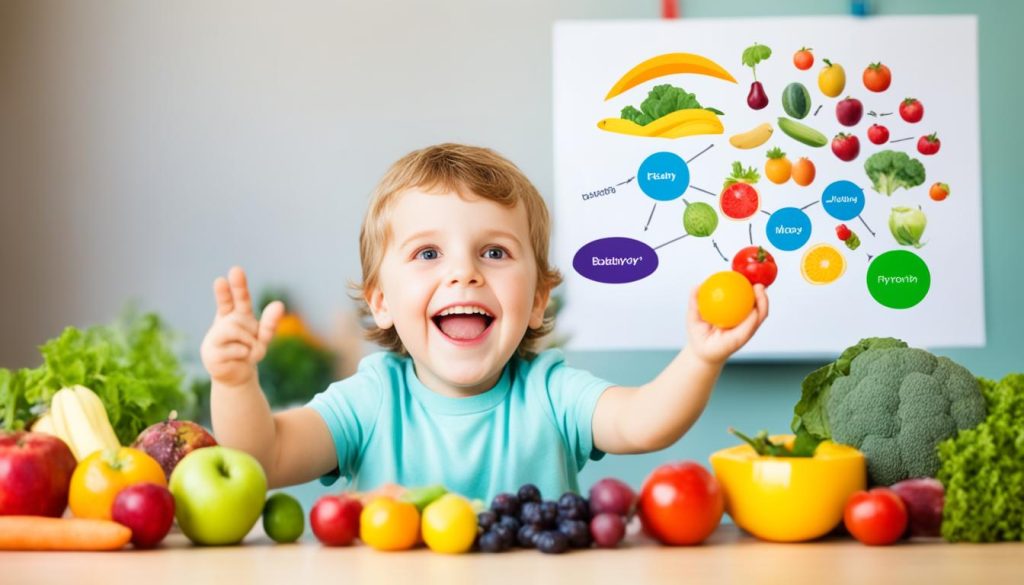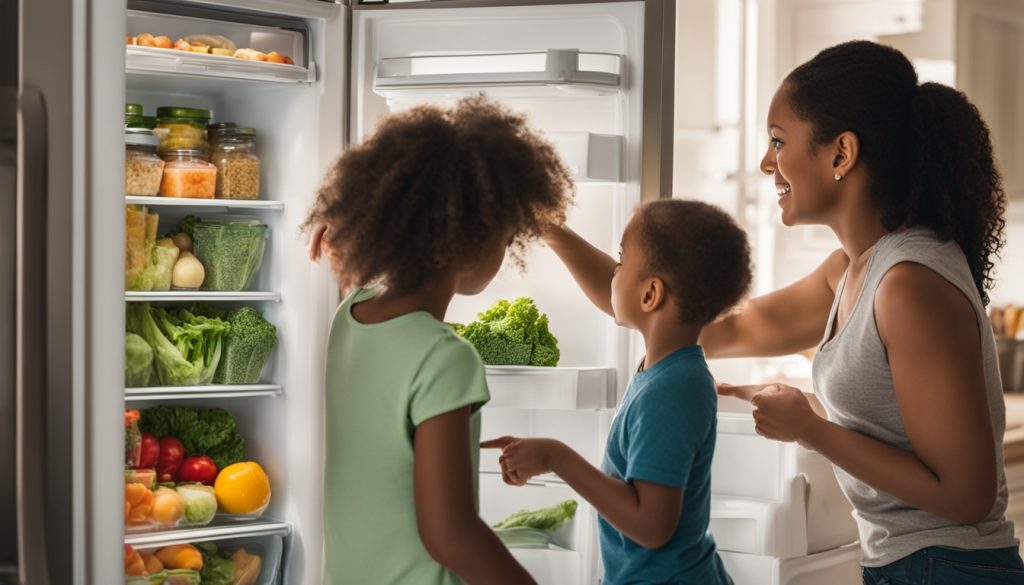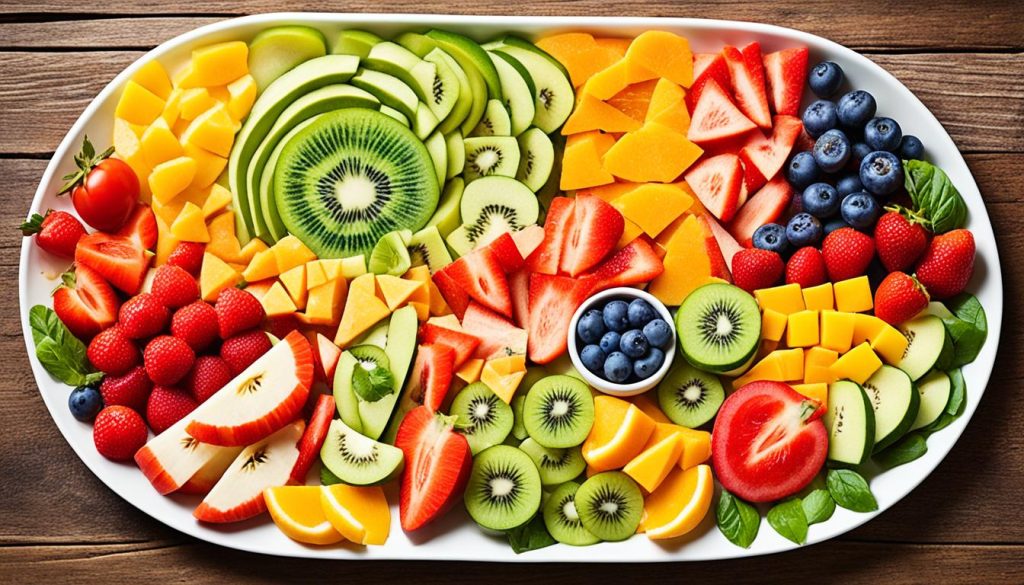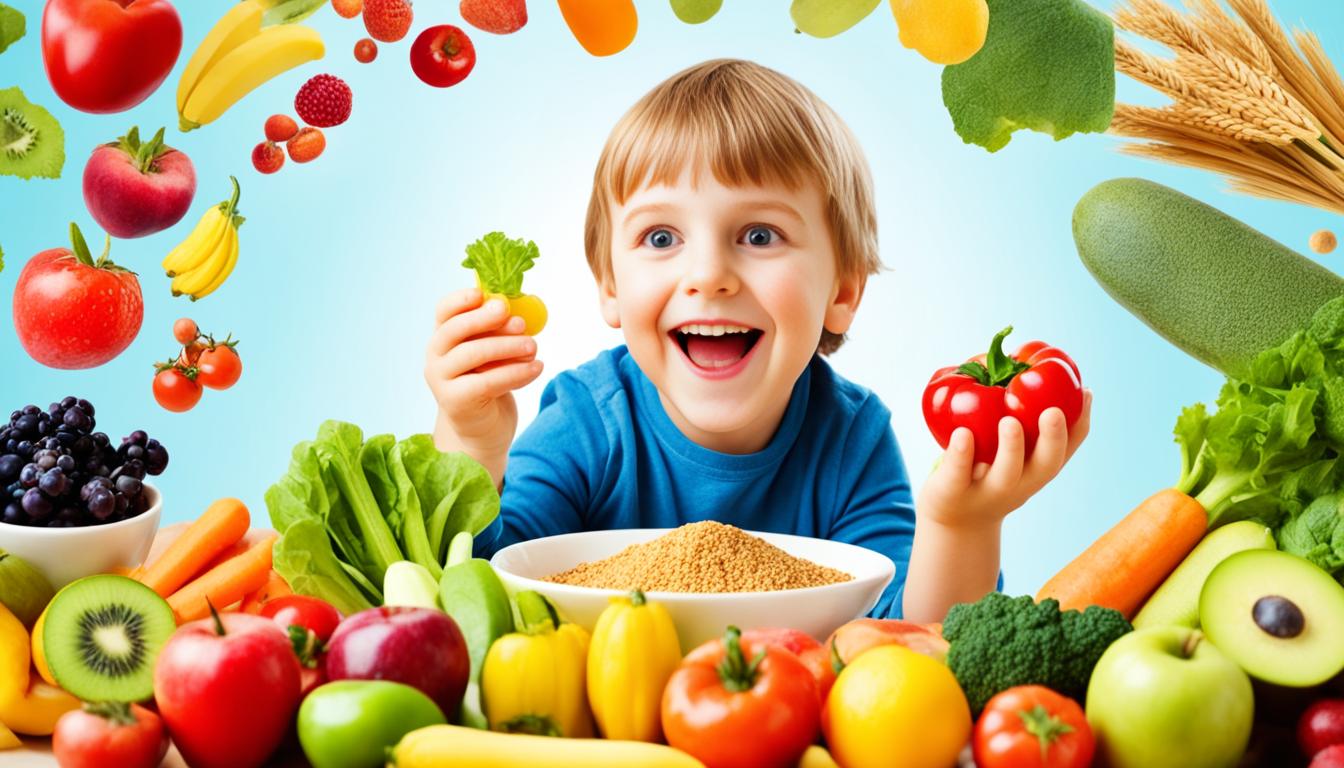Imagine a sunny Sunday afternoon with your family at the dinner table. You’re sharing stories and laughter over a meal you made. Seeing your child pick veggies shows these moments are about love and values. Parenting is a journey where food choices affect their health and self-esteem.
Creating a positive food environment is about love and connection. It’s about teaching your child about food’s cultural and social importance. Isabel Reckson, a dietitian at Weill Cornell Medicine, says every family’s food journey is different. A healthy relationship with food means making choices that respect the body without guilt.
Letting your child make meal choices and help with cooking teaches them important skills. It also builds their confidence and sense of responsibility. This, along with positive parenting, helps them develop healthy eating habits. Sharing meals, talking about food positively, and making dinner fun helps your child’s emotional and physical health.
Key Takeaways
- Parents significantly influence their child’s eating behaviors and attitudes towards food.
- Cultural and social contexts are integral to developing a healthy relationship with food.
- Modeling positive food behaviors and avoiding negative labels can foster a balanced food perspective.
- Involving children in meal preparation and choices encourages food acceptance and enjoyment.
- Establishing shared meals can enhance family bonds and promote healthy eating habits.
Understanding the Importance of a Healthy Relationship with Food
Food is key to a child’s growth, both in body and mind. It helps build family bonds and encourages healthy eating habits early on. A balanced and flexible approach to food is key for a good relationship with it.

The Role of Food in Cultural and Social Contexts
Food is a big part of culture, often at the heart of family traditions. Sharing meals teaches kids about teamwork, sharing, and their heritage. These moments help kids understand community, identity, and respect for different foods.
Defining a Healthy Relationship with Food
A healthy food relationship means finding balance, trying new things, and enjoying meals. It’s about seeing food as both a source of nourishment and joy. Teaching kids to value different foods and listen to their bodies helps them connect with food positively.
Parents are key in teaching good eating habits by eating well themselves. Making meals fun and consistent helps kids develop good eating habits. This is vital for their health and social skills.
The Role of Parents in Shaping Child’s Eating Habits
Parents have a big impact on their child’s eating habits. What they do and say matters a lot. The way parents feed their kids and the family meal setting affects their eating habits. Setting clear rules and positive parenting can lead to better eating habits and overall health.
Modeling Positive Eating Behaviors
It’s key to show good eating habits yourself. Kids often follow what their parents do. Isabel Reckson says it’s important to avoid bad food talk and teach kids to enjoy all foods. Setting boundaries with kids helps them understand moderation without feeling trapped.
Avoiding Negative Food Labels
Don’t call foods ‘good’ or ‘bad.’ Instead, encourage trying different foods. This helps manage screen time by making meals more focused. Not using negative food labels keeps eating healthy in perspective.
Encouraging Balanced and Flexible Eating
It’s important to promote a balanced diet without being too strict. Let kids help plan and make meals. This teaches them about nutrition and responsibility. Being involved in meal choices helps them stick to healthy eating habits.

Looking at how we eat as a family helps us improve our kids’ nutrition. Being involved parents creates a space for balanced eating. By encouraging everyone to eat together and understanding our actions, we help kids develop good eating habits for life.
Mindful Eating Practices for Children
In today’s digital world, teaching kids to eat mindfully is key. Experts like Isabel Reckson say mindful eating means paying attention to food. It helps kids connect with their hunger and fullness signals. Plus, letting kids explore their hobbies and creativity can make them more balanced with food.

Recognizing Hunger Cues
It’s important for kids to know when they’re hungry. It can take 15 to 30 minutes for the brain to feel full. Letting kids serve themselves helps them learn how much to eat and understand their hunger.
Tips for Mindful Eating
Adding mindful eating to daily life is good for kids. Here are some tips:
- Encourage slow eating to let fullness set in.
- Make them thankful for their food to build a good food relationship.
- Let kids help with meal prep to make them curious and appreciative.
- Show them good eating habits to make it a habit.
Benefits of Structured Meal and Snack Times
Having set times for meals and snacks is great for kids. It helps them know when they’re hungry and can prevent bad eating habits. Kids love routine, especially in the early years, because it makes them feel safe and secure.
| Factor | Benefit |
|---|---|
| Consistent Meal Times | Helps children recognize hunger and fullness cues |
| Mindful Eating Practices | Reduces the risk of developing eating disorders |
| Family Meals | Encourages slow eating and enjoyment of food |
| Responsive Feeding | Fosters healthy eating habits and decreases overeating risks |
In the end, being a parent today means teaching kids about food manners. By supporting their hobbies and creativity with structured meals and mindful eating, you guide them to a healthier food relationship.
Incorporating a Variety of Nutrient-Dense Foods
Teaching kids about nutrient-dense foods is key for their health and fullness. A diet full of different, healthy foods helps kids develop good eating habits. Making sure their diet has lots of fiber, protein, and water is also important. It helps them feel good and supports their activities.
Importance of Fiber for Fullness
Fiber is found in fruits, veggies, whole grains, and seeds. It helps with digestion and keeps you feeling full longer. In 2015-16, kids’ diets scored low in veggies, showing the need for more fiber. Eating more fiber helps kids digest better and stay energetic.
Protein Sources for Satiety
Protein helps kids feel full. You can get protein from animals and plants. Foods like full-fat dairy, eggs, and fish like salmon are great sources. They give kids the energy they need and help them feel independent.
The Role of Hydration
Drinking enough water is key for carrying nutrients and feeling full. Water helps with many body functions and stops kids from eating too much. Drinking enough water is easy and helps kids eat better and stay healthy.

Studies link a healthy food home with better eating habits and more fruits and veggies. Adding these foods to your child’s diet helps them eat well for life. It also boosts their self-esteem and supports their growth.
Addressing Common Eating Behaviors
Understanding and managing common eating behaviors in children can be tough. Actions like skipping meals or sneaking food can happen. It’s important to talk to your child about why they do these things. This way, they feel heard and understood.
Dealing with food-related tantrums is common too. Instead of punishing your child, use strategies that help them feel understood. For example, if they skip a meal, talk about their hunger cues. Teach them to recognize when they’re really hungry or full.
Helping your child be independent at meal times can lead to better choices. Let them help plan and prepare meals. This teaches them about nutrition and builds responsibility. Plus, kids are more likely to eat what they’ve made, cutting down on negative eating habits.
Teaching kids to be grateful during meals can also help their eating habits. Encourage them to see the hard work in meal prep. This can make them less picky and more thankful for their food.
- Avoid forcing children to eat at specific times; instead, listen to their hunger and fullness cues.
- All foods should be allowed unless there’s an allergy, reinforcing that no food is inherently “bad” or “good”.
- Focus on overall well-being rather than weight, emphasizing that mental health is as vital as physical health.
Using these strategies can help your child develop healthy eating habits and a good relationship with food. It also helps manage tantrums and encourages independence at meal times. Remember, patience and understanding are key to effective discipline.
Fostering Emotional Intelligence in Children Through Food Choices
Food choices are a great way to support child mental health and emotional smarts. Understanding the parent-child bond can shape a child’s eating habits and overall health.
Talking openly about food and feelings helps kids develop a good relationship with eating. By exploring emotions tied to eating, you help kids manage their food habits better.
Open Conversations About Food and Emotions
Talking about food and feelings boosts a child’s emotional smarts. By sharing how certain foods affect them, kids learn to recognize their emotions. This is key for their mental health and learning to eat emotionally healthy.
Studies show 85% of kids with emotional smarts handle stress and feelings better, eating less junk food. These talks give kids tools to manage their feelings, leading to healthier eating habits.
Avoiding Emotional Eating Patterns
To stop emotional eating, spot and meet emotional needs. Encourage kids to find other ways to deal with sadness, stress, or boredom. Things like music or helping others can boost self-esteem by 40%, offering better ways to cope than eating.
- Kids who enjoy physical activities for fun, not just to lose weight, are less likely to have a bad body image.
- Kids who help with meal planning and cooking eat healthier and enjoy meals more, by 45%.
- 70% of kids who help with meal planning pick healthier foods.
Regular family meals help kids understand food and feelings better, boosting their emotional smarts. Parents play a big role in creating a space where talking about food and feelings is normal. This sets the stage for healthier, happier lives.
| Factor | Percentage Improvement |
|---|---|
| Children with parents who model healthy eating behaviors | 35% |
| Children involved in meal planning and cooking | 70% |
| Children engaging in non-appearance based activities | 40% |
| Children taught emotional intelligence skills | 85% |
| Children involved in physical activities for enjoyment | 50% |
| Families involving children in food choices and preparation | 45% |
| Successful intervention outcomes for early signs of disordered eating behaviors | 60% |
The Significance of Regular Meals and Snacks
Regular meals and snacks are key for kids’ growth. They help kids learn about a balanced diet through positive parenting. A steady eating schedule also builds respect and empathy in families, making mealtimes less stressful.
Creating Consistent Eating Schedules
A steady eating plan helps kids know when they’re hungry or full. A 2018 study found that kids who eat with their families eat more fruits and veggies and less junk food. This routine is good for kids’ social skills, as it helps them talk and bond with their families.
Benefits of Predictable Meal Times
Predictable meal times do more than just feed kids. They boost kids’ confidence, grades, and feelings of well-being. A 2015 review showed that eating together often can prevent eating disorders and other problems. A 2022 survey found that families who eat together feel less stressed.
Regular family meals are great for kids’ social growth. They teach kids about respect and empathy, which are important for a happy home. By sticking to a meal schedule, families help their kids do well emotionally and nutritionally.
| Study | Key Findings |
|---|---|
| JAMA Network Open (2018) | Better diet quality among adolescents with regular family meals. |
| American Heart Association Survey (2022) | 91% of parents report lower stress levels with regular family meals. |
| Canadian Study (2015) | Prevention of eating disorders, substance use, and depression among teens. |
| Journal of Pediatrics (2010) | Reduced obesity rates in adolescents with consistent family meals. |
Parenting and Raising Kids With a Focus on Positive Food Relationships
Building a good relationship with food is key for parenting and raising kids. It’s important to use positive words when talking about food. Avoid focusing on diets or weight. Encourage a mix of foods on the plate.
Promoting Positive Food Language
Positive words about food help kids see eating as good. Instead of calling foods ‘good’ or ‘bad’, say they are ‘everyday’ or ‘sometimes’ foods. This way, you teach balance without making them feel guilty.
Avoiding Diet and Weight Talk
Don’t talk about dieting or weight in front of kids. This stops them from having bad feelings about food. Talk about how nutrition gives energy and helps them grow strong.
Encouraging a Balanced Plate
A balanced plate with many foods is good for health. Show kids different fruits and vegetables. Make meal times fun with special days like “Taco Tuesday” or “New Food Friday”. Let them try new foods and eat from all food groups.
| Strategy | Benefit |
|---|---|
| Promoting Positive Food Language | Helps children view foods with a balanced perspective |
| Avoiding Diet and Weight Talk | Prevents negative food associations |
| Encouraging a Balanced Plate | Ensures nutritional diversity |
Using these methods daily improves your child’s food relationship. It also helps them become resilient. By teaching them to try different foods, you’re giving them a healthy eating habit for life.
Fun and Nutritional Snack Ideas for Kids
Offering kids fun and healthy snack options is key to meeting their dietary needs and building a love for food. When kids help prepare their snacks, they’re more likely to eat and enjoy them. This activity is great for raising kind children, starting family traditions, and helping kids develop a growth mindset.
Snacks that mix fiber and protein help keep kids full and support their learning. Here are some exciting ideas:
- Mini Pizzas: Kids can make their own mini pizzas on French bread, bagels, English muffins, or tortillas. Use a simple crust mix of 1 cup Greek yogurt and 1 3/4 cup self-rising flour.
- Trail Mix: Let kids mix different ingredients like raisins and whole nuts in small containers. It’s a fun way to try new flavors and textures.
- Veggie Pita Pockets: Make eating veggies fun by filling pita pockets with a variety of veggies and dip.
- Yogurt Parfaits: Layer fruits, granola, and yogurt in parfaits for a sweet snack that’s also good for you.
- Smoothies: Blend fruits, veggies, yogurt, and juice for a refreshing snack that’s packed with nutrients.
- Cheese and Crackers: Classic snacks like cheese and crackers or “ants on a log” (celery with peanut butter and raisins) offer protein and healthy fats.
Let’s explore how these snacks meet nutritional needs:
| Snack Idea | Key Nutrient | Benefits |
|---|---|---|
| Mini Pizzas | Protein & Fiber | Supports growth and satiety |
| Trail Mix | Fiber & Healthy Fats | Promotes digestive health |
| Veggie Pita Pockets | Fiber & Vitamins | Enhances overall health |
| Yogurt Parfaits | Calcium & Protein | Strengthens bones |
| Smoothies | Vitamins & Fiber | Boosts immune function |
| Cheese and Crackers | Protein & Calcium | Supports muscle growth |
Healthy snacks do more than just meet nutritional needs. They also help build family traditions and a lifelong love of good food. This supports a positive food relationship, which is key for kids’ growth and learning.
Engaging Your Child in Meal Planning and Preparation
Getting kids involved in meal planning and cooking is more than just a task. It’s a chance to bond and teach them important life skills. Studies show that kids who help with cooking are more likely to try new foods. They also get better at planning and organizing, thanks to their kitchen work.
Benefits of Involving Kids in Cooking
Kids in the kitchen can change how they see food and eating. Families that cook together eat more veggies, for instance. It boosts kids’ confidence as they learn to cook and help with meals.
It’s also a great way to teach kids about different foods and cultures. They get to try new things and learn to appreciate diversity. This helps them grow up open-minded and accepting.
Creating Opportunities for Nutrition Education
Meal planning and cooking are perfect times to teach kids about healthy eating. Kids who shop for groceries with their parents know more about food groups. Using kid-friendly tools makes cooking fun for them, says 82% of parents.
Activities like measuring and following recipes teach kids important skills. They learn about healthy eating and are more likely to eat what they make. This can make family life easier for parents, turning cooking into a fun family activity.
Building Healthy Food Habits From a Young Age
Starting healthy eating habits early shapes your child’s future with food. It teaches them responsibility and connects with teaching them to be responsible. This helps them understand the value of food.
Establishing Lifelong Healthy Eating Patterns
Regular meal times help kids develop good eating habits for life. Feeding them a mix of fruits, veggies, lean proteins, and whole grains is key. It’s also important to limit foods high in sugar and fats.
Seeing parents eat well sets a good example for kids. It shows them the value of respect and empathy in the family.
- Encourage consumption of five servings of fruits and vegetables per day.
- Provide healthy snack options such as low-fat yogurt, whole-grain crackers, and fruit.
- Offer water and low-fat milk as preferred drink choices over sugary beverages.
The Role of Routine in Eating Habits
Having a routine is key to eating well. Regular family meals help kids avoid unhealthy snacking and choose better foods. These meals also protect them from smoking or drinking too young.
“Kids who regularly participate in family meals are more likely to develop healthy eating habits and are less likely to engage in unhealthy behaviors.” – Source
Letting kids help with meal planning makes cooking fun and teaches them about food. This helps them read nutrition labels and make smart choices. Adding these habits to your family’s life boosts kids’ health and happiness. It shows how important sleep is for kids too.
Conclusion
Building a healthy relationship with food for your child is more than just what they eat. It’s about emotional support, personal growth, and positive talks. It’s like getting them ready for kindergarten, but for eating well for life.
Play is key in child development, helping with emotional and brain growth. Using good discipline and talking openly about food and feelings helps your child a lot.
When talking about hard topics like food or life, be sensitive and understanding. Parents who focus on emotional smarts and eating mindfully help set up a healthy future. Avoiding negative food talk is important too.
Your effort and consistency in helping your child understand food can make a big difference. This, along with their emotional and brain growth, helps them become well-rounded. They’ll be able to make good choices for their whole life.
FAQ
What is the role of food in cultural and social contexts?
How can parents define and promote a healthy relationship with food for their children?
What steps can parents take to model positive eating behaviors?
How can structured meal and snack times benefit children?
What are the benefits of involving children in meal planning and preparation?
How can parents address common eating behaviors like food “sneaking” or skipping meals?
How does promoting positive food language help in building healthy eating habits in children?
How can parents foster emotional intelligence in children through food choices?
What are some fun and nutritious snack ideas for kids?
Why is it important to establish lifelong healthy eating patterns from a young age?
This post contains affiliate links. If you click on a link and make a purchase, I may earn a small commission — at no extra cost to you. Thank you for supporting this blog and helping me keep the patterns free! Read the full Affiliate Disclosure & Transparency.
